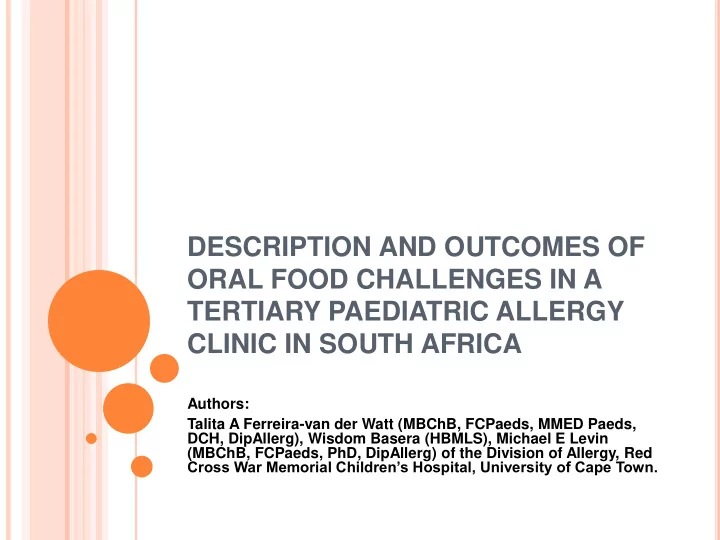

DESCRIPTION AND OUTCOMES OF ORAL FOOD CHALLENGES IN A TERTIARY PAEDIATRIC ALLERGY CLINIC IN SOUTH AFRICA Authors: Talita A Ferreira-van der Watt (MBChB, FCPaeds, MMED Paeds, DCH, DipAllerg), Wisdom Basera (HBMLS), Michael E Levin (MBChB, FCPaeds, PhD, DipAllerg) of the Division of Allergy, Red Cross War Memorial Children’s Hospital, University of Cape Town.
B ACKGROUND The gold standard for diagnosing food allergy is the double-blind, placebo-controlled oral food challenge. Open food challenges (OFC) are useful to exclude food allergies. 1 In the clinical setting OFC’s are used to exclude true allergies, determine tolerance and confirm presence of true allergy where history and SPT/IgE tests are not conclusive.
Sampson 2 determined 95% PPV of specific IgE for food challenge outcome in children in a first world country. Decision points determined 3 : Food IgE (kU/l) Egg > 2 years old 7 Egg < 2 years old 2 Cow’s milk > 2 years old 15 Cow’s milk < 2 years old 5 Peanut 14 Predictive values for African children have not been determined.
M ETHODS Retrospective, descriptive study Children 0 to 14 years Red Cross Children’s Hospital’s tertiary Allergy clinic OFC 39 month period from February 2011 to April 2014
31.7% Egg R ESULTS Peanut 202 OFC 18.3% 14.4% 142 children Baked 12.4% egg 9 months to 14 years Cow's 18 different foods milk Challenge foods Racial group Number of patients Mixed race 170 (84.1%) Black African 26 (12.9%) White 2 (3%)
18.8% (n=38) OFC were positive Urticaria: 60.5% (n=23) Angioedema 28.9% (n=11) Wheeze 7.9% (n=3) Positive OFC 36.0% (9/25) 21.5% 14.5% (14/65) (10/69) 11.6% (5/43) 2011 2012 2013 2014
Younger children = higher incidence of positive OFC 33.3% in children below 2 years (n=14/42) 9.2% (n=24/260) in children above 2 years (p=0.01) Baked egg Cow’s milk P value Egg Peanut Positive 14% 35.1% 17.2% 20% OFC (n=9/64) (n=13/37) (n=5/29) (n=5/25) Median age 53 months 67 months 38 months 29 months p=0.01 at challenge (all 4 groups) Mixed Black White P-value race African Median 47 42 117 0.007 age at months months months Kruskal challenge Wallis Positive 18.8% 15.4% 33.3% 0.5 OFC (32/170) (4/26) (2/6) Fisher outcome exact
Co-morbidities atopic dermatitis 73.9% (n=105/202) asthma 37.3% (n=53/202) allergic rhinitis 45.8% (n=65/202) allergy to multiple foods 62.7% (n=89/202) Co-morbidity prevalence was significantly different between groups with positive and negative OFC outcomes (p<0.01).
Number of negative OFC’s with IgE levels above the internationally derived 95% positive predictive values. Mixed race Black African Egg 36.1% 42.9% (n=17/47) (n=3/7) Cow’s milk 40% 80% (n=6/15) (n=4/5) Peanut 21.7% 0% (5/23) (n=0/1)
C ONCLUSION OFC Necessary to accurately diagnose children with food allergies Assess development of tolerance Majority of food challenges are negative Positive OFC usually have mild reactions Increased utilisation of OFC’s increased numbers of true food allergy diagnoses Prevalence of positive challenges and age at the time varies between different foods. Younger children had an increased risk of positive OFC outcome. Peanut allergy was the most common food allergy diagnosed. Those children with positive food challenges had a significantly higher degree of allergic co-morbidity.
Large numbers of patients have negative challenges despite IgE levels above the internationally derived 95% PPVs. A higher proportion of Black African children have negative egg and milk challenges despite IgE levels above the internationally derived 95% PPVs References: 1. Leung DYM, Sampson HA, Geha R, Szefler SJ. Pediatric allergy. Principles and practise. 2nd edition. Saunders Elsevier: 2010. 2. Sampson HA. Utility of food-specific IgE concentrations in predicting symptomatic food allergy. J Allergy Clin Immunol. 2001 May; 107(5): 891-896. 3. Sampson HA. Food allergy. J Allergy Clin Immunol. 2003 February; 111(2): S540- 547.
T HANK YOU
Recommend
More recommend